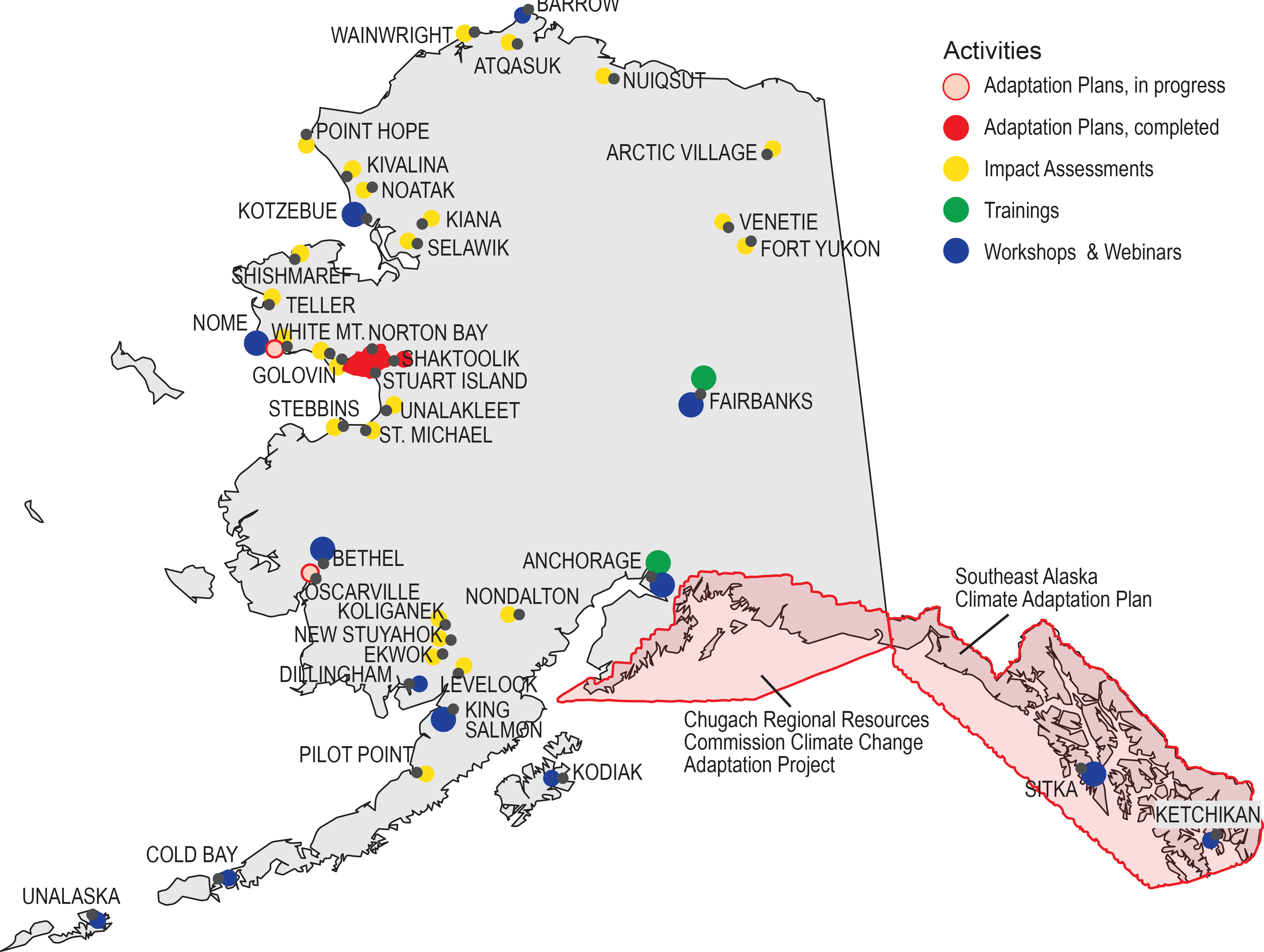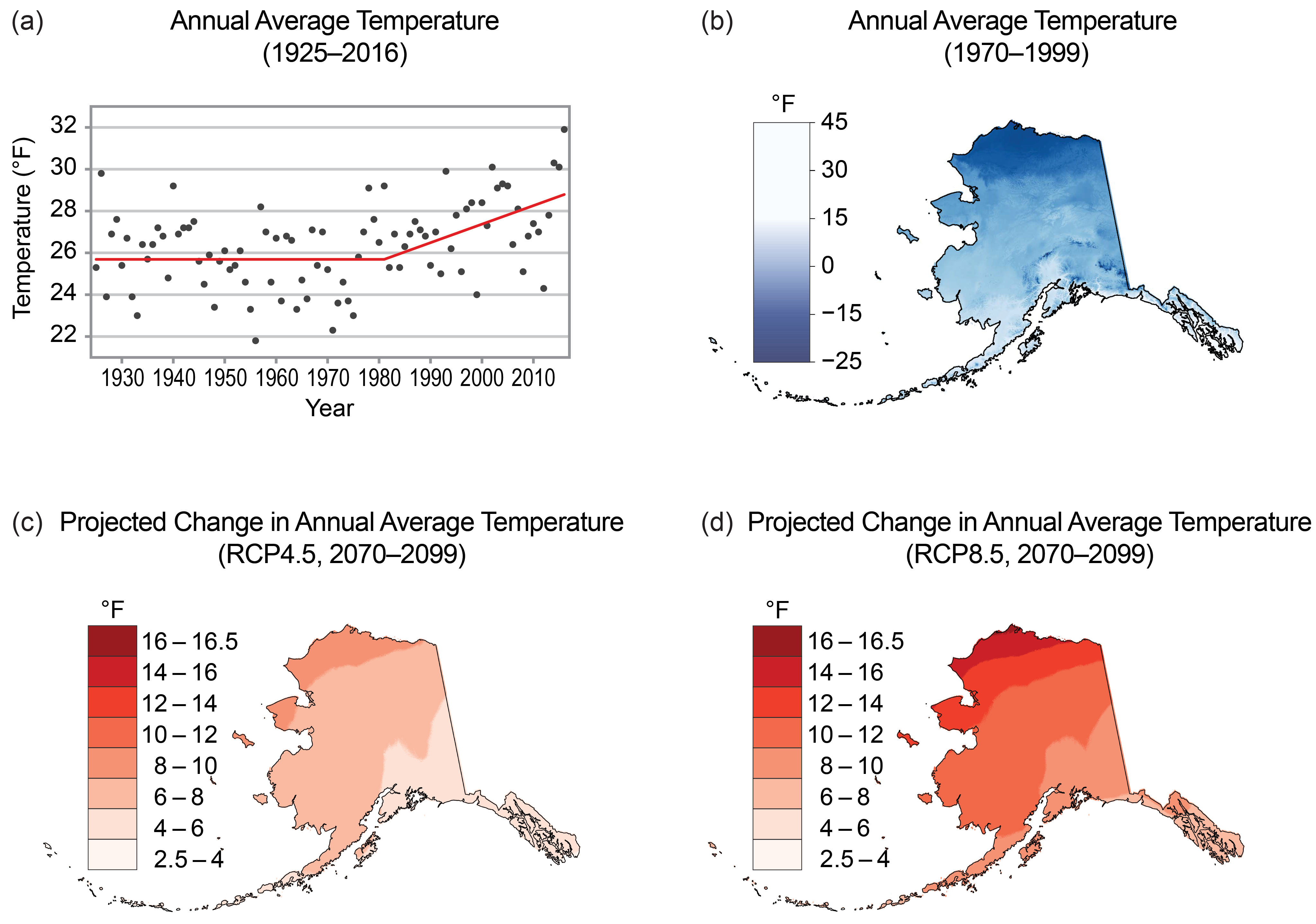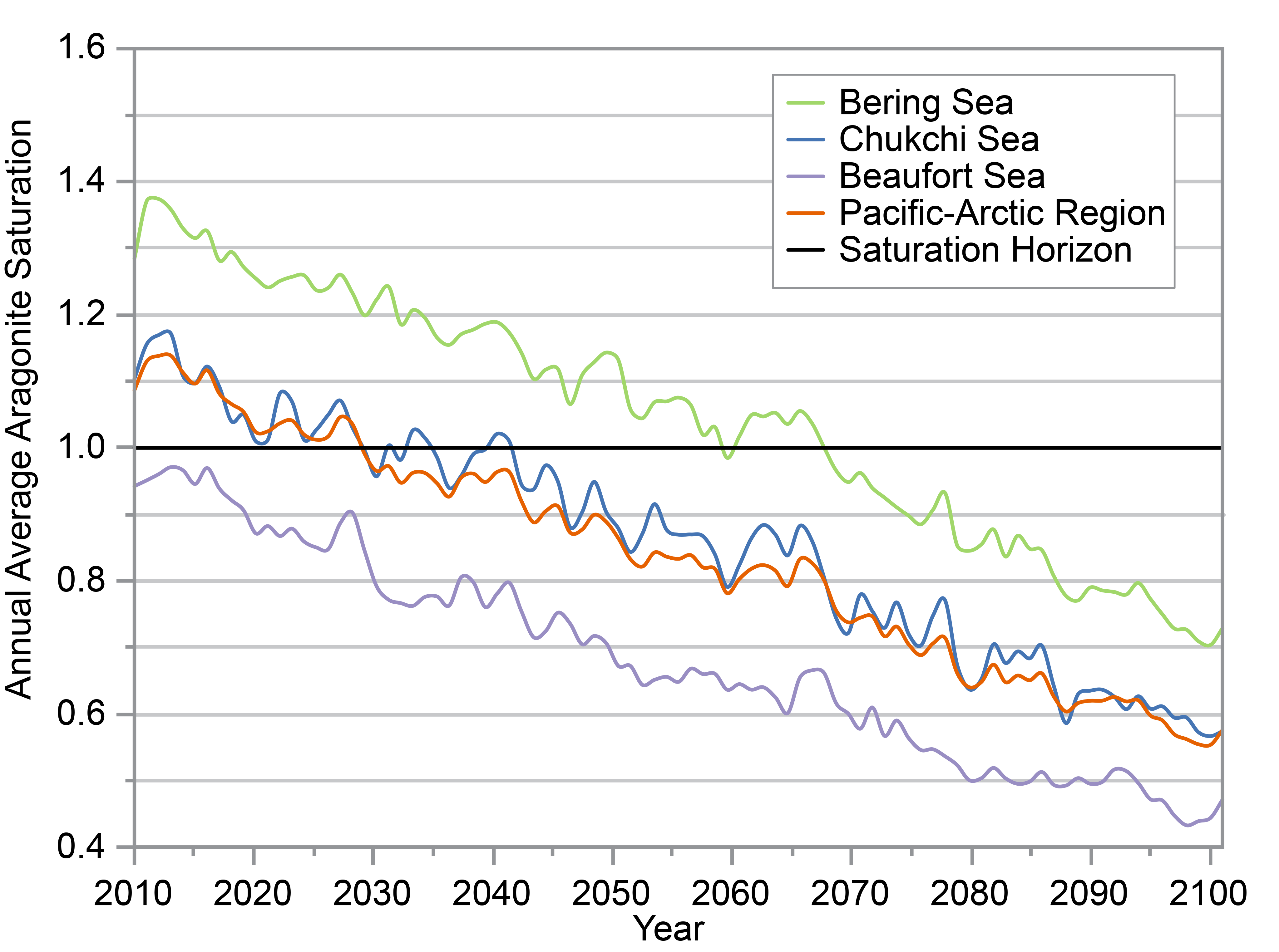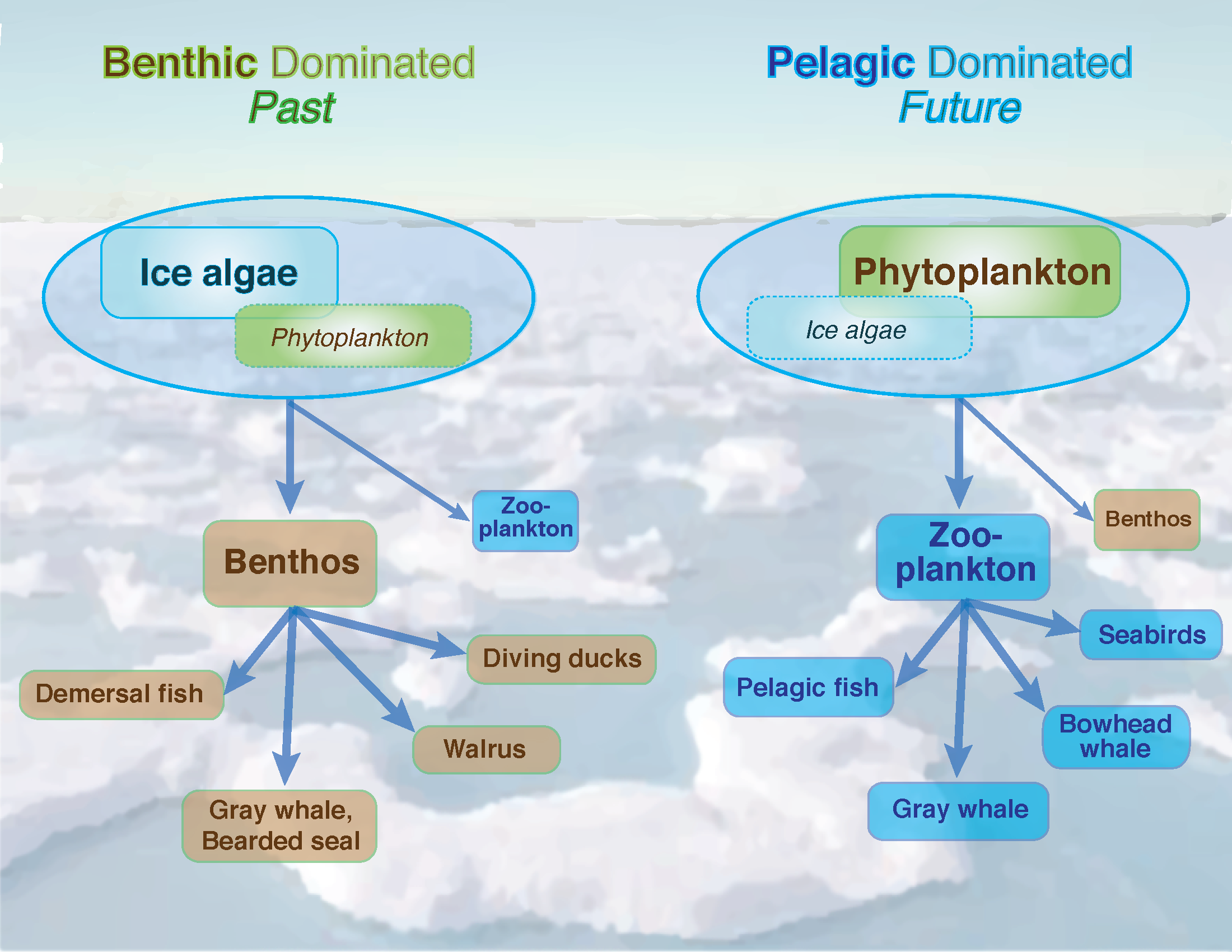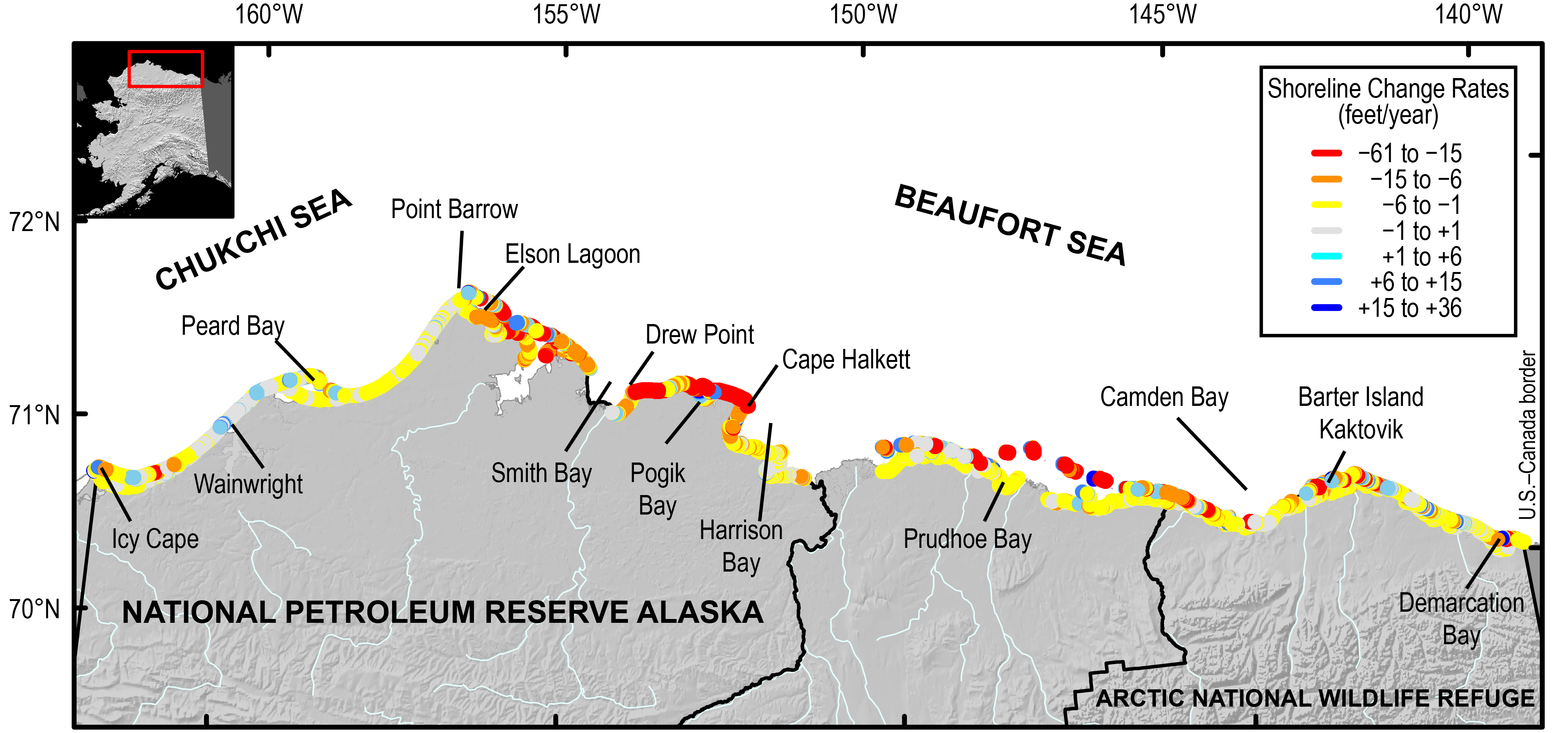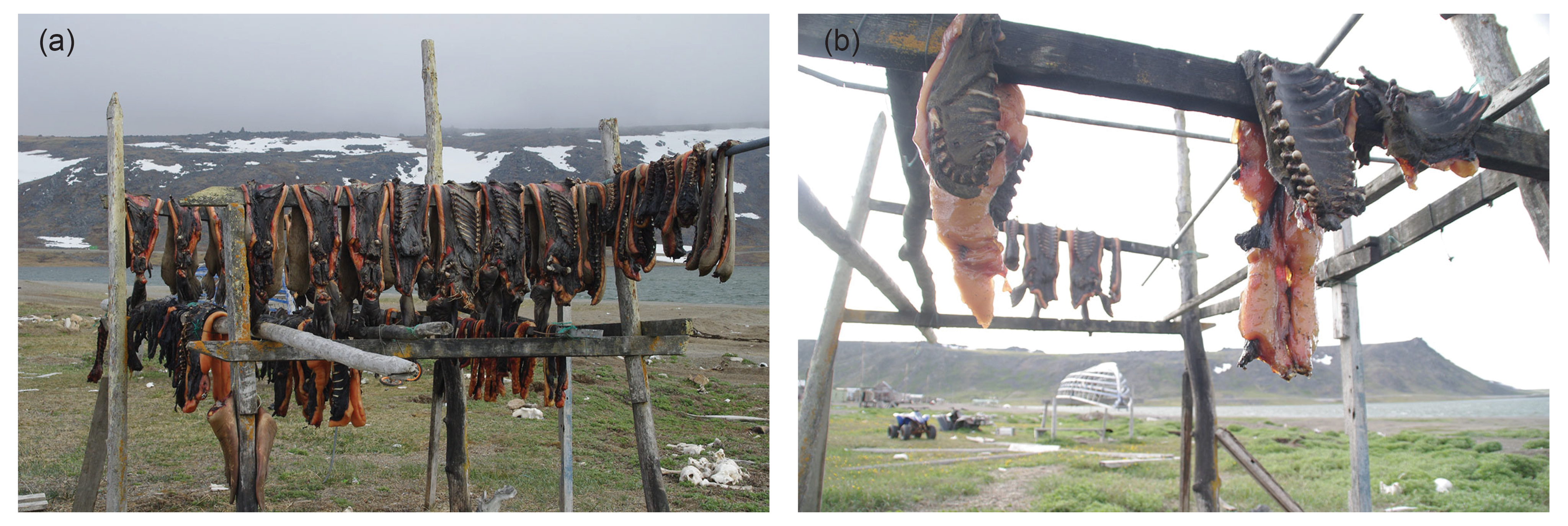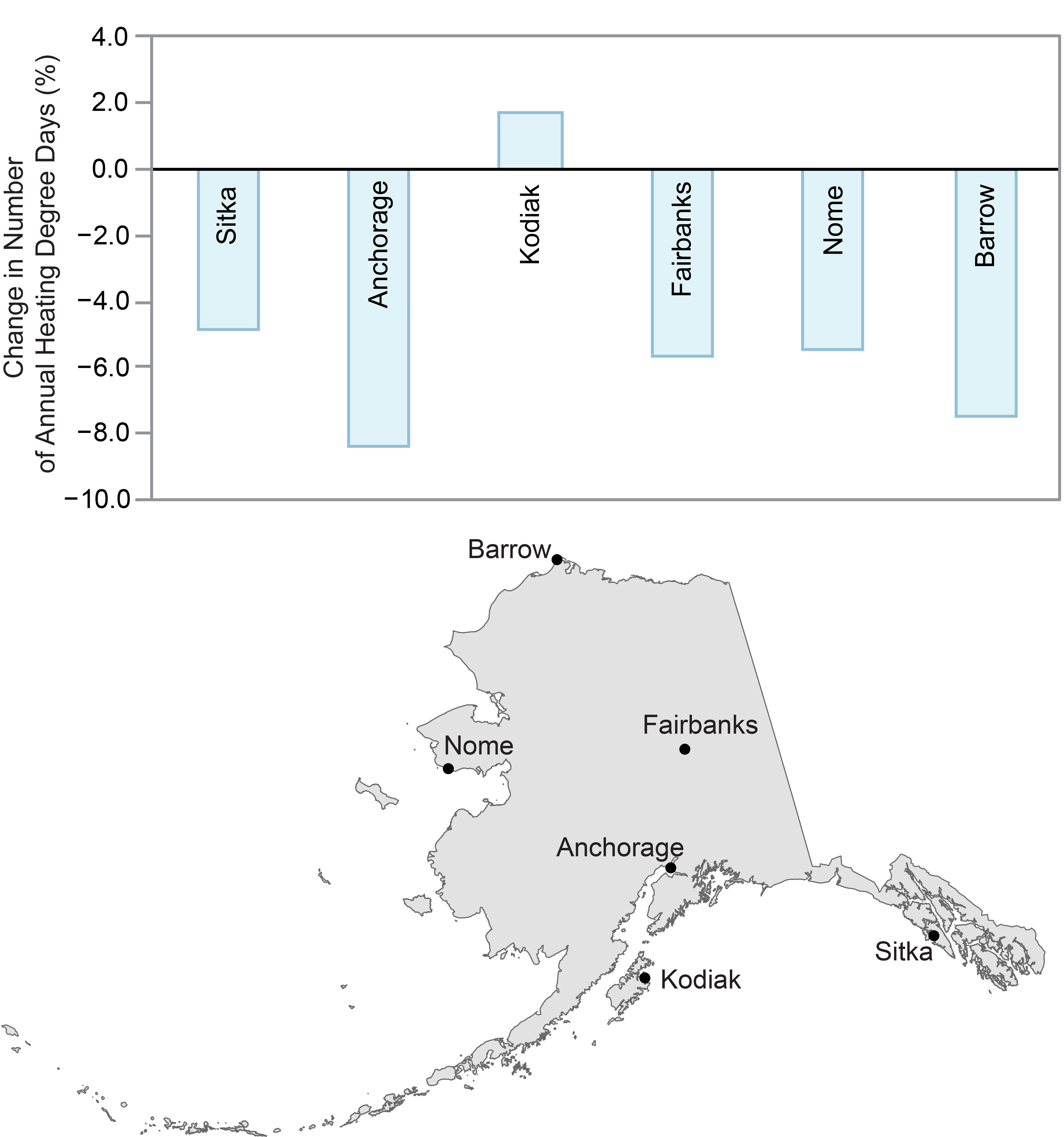The Alaska regional chapter was developed through public input via workshops and teleconferences and review of relevant literature, primarily post 2012. Formal and informal technical discussions and narrative development were conducted by the chapter lead and contributing authors via email exchanges, teleconferences, webinars, in-person meetings, and public meetings. The authors considered inputs and comments submitted by the public, the National Academies of Sciences, Engineering, and Medicine, and federal agencies. The author team also engaged in targeted consultations during multiple exchanges with contributing authors, who provided additional expertise on subsets of the Traceable Account associated with each Key Message.
Key Message 1: Marine Ecosystems
Alaska’s marine fish and wildlife habitats, species distributions, and food webs, all of which are important to Alaska’s residents, are increasingly affected by retreating and thinning arctic summer sea ice, increasing temperatures, and ocean acidification. Continued warming will accelerate related ecosystem alterations in ways that are difficult to predict, making adaptation more challenging (very likely, very high confidence).
Description of evidence base
Changes in arctic sea ice and its impacts on marine ecosystems and various biological resources are well documented by 38 years of satellite records280 and the scientific literature.48,50,51,77,78,79,281 The finding of a continuing retreat of arctic sea ice is supported by sea ice modeling and continued CO2 emissions.37,46 The northward distribution of ocean fish species is documented by numerous scientific papers: see Perry et al. (2005),282 Thorsteinson and Love (2016),17 and Mecklenburg et al. (2002).72 The impacts of an increased open Arctic sea contributing to increases in ocean acidification18 and expanding deeper into the Arctic Basin57 will need validation with further studies.
Major uncertainties
To date, relatively few of Alaska’s marine species have been studied for their response to ocean acidification, and the assessment of potential impacts is challenging due to each species’ differing habitats, life cycle stages, and response and adaptation mechanisms. It is known that some organisms respond more dramatically to environmental change than others, and warming ocean temperatures may be more significant in the short term than ocean acidification. There is significant uncertainty in the projected increase of shipping through the Arctic and the Bering Strait, since much of this increase will be driven by economic factors and not climate or other environmental change.
Description of confidence and likelihood
There is very high confidence that the arctic sea ice will continue to reduce in size over the next 20–40 years, and it is likely that the Arctic Ocean will be nearly ice-free in late summer by mid-century based on current climate models. There is also high confidence that this melting will have an effect on the northward expansion of North Pacific fish species and associated effects on associated food webs. There is very high confidence that continued melting of the Arctic Ocean ice will have an effect on the habitat and behavior of polar bear and walrus. There is high confidence that Alaska’s ocean waters are becoming increasingly acidic. Given this increase, it is very likely that there will be biological impacts, but it is uncertain which species will be affected and to what extent.
Key Message 2: Terrestrial Processes
Alaska residents, communities, and their infrastructure continue to be affected by permafrost thaw, coastal and river erosion, increasing wildfire, and glacier melt. These changes are expected to continue into the future with increasing temperatures, which would directly impact how and where many Alaskans will live (very likely, high confidence).
Description of evidence base
Permafrost
Multiple studies of permafrost in Alaska have shown that the gradual warming of the ground105 has resulted in the warming and thawing of permafrost over the past 30 years,79,104,106 and spatial modeling projects that near-surface permafrost will potentially disappear on up to a quarter of the landscape by the end of the 21st century.108 The magnitude of these changes depends on climate and ground-ice conditions, where permafrost thaw generally results in drier upland habitat and wetter lowlands as tundra and forests are converted to lakes and bogs.106,283 These changes will undoubtedly result in a number of societal consequences, loss of wildlife habitat, damage to infrastructure (including buildings, airport runways, tank farms, and roads), ecosystem contamination, and increased maintenance costs.20,21,91,207,284,285
Wildfire
It has been well documented that wildfires are a common occurrence in Alaska, especially the interior boreal areas, although they have also occurred in areas of arctic tundra,114,286 with some of the largest fire years (1–6 million acres) occurring between 2004 to 2016 since records began around 1950.114 Recent studies show that changes in wildfire across the Alaska landscape could be attributed to human activity.287 This has resulted in changes in boreal vegetation cover95,96 and tundra communities.286 The increased fire frequency of recent decades is expected to continue into the future, in spite of the change to less flammable deciduous vegetation, because of the accompanying change to warmer and drier conditions.95 The ground is warmer under post-fire deciduous vegetation, and thus fires will enhance the thaw of permafrost that is already underway due to climatic warming.288
Coastal and River Erosion
The shoreline along Alaska's northern coast has eroded at some of the fastest rates in the Nation, putting local communities, oil fields, and coastal habitat at risk.19 Unlike the contiguous United States, Alaska is subject to glacial and periglacial processes that make permafrost and sea ice key controlling factors of coastal erosion and flooding. Thermal degradation of permafrost leads to enhanced rates of erosion along permafrost-rich coastal shorelines19 and subsidence of already low-lying regions. Longer sea ice-free seasons, higher ground temperatures, and relative sea level rise are expected to exacerbate flooding and accelerate erosion in many regions, leading to the loss of more shoreline in the future.19
While erosion and changed river courses are a normal part of landscape evolution, lateral river erosion rates are likely to change over time, but the direction and magnitude of these changes are poorly understood. Major river erosion events are typically tied to high hydrological flows or the melting of permafrost along river and stream banks. Statewide, evidence for changes in maximum gauged streamflows is mixed, with a majority of locations having no significant trend.289 There is significance for seasonal changes in the timing of peak flows in interior Alaska, though increases in the absolute magnitude are not well evident in existing data.290 Riverine erosion is a serious problem for a significant number of communities.123 Significant resources have been expended to slow erosion at some communities, often through the construction of berms and bank stabilization projects. These projects have a mixed record of success and nearly always require ongoing maintenance.
Glacier Change
Airborne altimetry surveys of Alaska glaciers spanning the 1994–2013 interval and covering about 40% of the region’s glacierized area137 yield decadal timescale mass balance estimates for individual glaciers and a regional estimate.291 Several new modeling studies suggest that the measured rates of Alaska ice loss are likely to increase in coming decades,139,140,141,142 with substantial regional-scale reductions in glacier area, volume (up to 40%–60% loss), and number. Moreover, physically based runoff models suggest that runoff from glaciers accounts for almost 40% of the total freshwater discharge into the Gulf of Alaska.292
Interdisciplinary research along the Gulf of Alaska is providing new insights into the role of glacier runoff in structuring downstream freshwater and nearshore marine ecosystems.101 End-of-century projections from physically based models suggest that anticipated atmospheric warming (2°–4.5°C) will drive volume losses of 32%–58% for Alaska glaciers.142 Increases in river chemical ions due to glacial runoff and permafrost melt have also been associated with diminishing glaciers in Alaska.94,291
Major uncertainties
Some events such as wildfires and coastal storms are dependent on regional and local current weather conditions, and the exact landscape or ecosystem response can be highly variable. Future effects are also dependent on quick response actions and adaptation measures.
Description of confidence and likelihood
There is high confidence that wildfire in Alaska will continue but medium confidence as to its ultimate effect on vegetation and permafrost, which is often dependent on fire fields available (e.g., older forests or new growth shrublands), the fire intensity, and the return rate. There is high confidence that the north coast of Alaska is eroding at high rates. It is likely that coastal erosion is accelerating in response to climate change but medium to low confidence as to the location and rate because of limited studies and datasets documenting this. There is high confidence that river erosion will continue but medium confidence as to when, where, and to what extent this will occur across Alaska because of differences in local climatic and geographic qualities of the area in question. There is high confidence and it is likely that the glaciers in Alaska will continue to diminish, especially those that are tidewater glaciers.
Key Message 3: Human Health
A warming climate brings a wide range of human health threats to Alaskans, including increased injuries, smoke inhalation, damage to vital water and sanitation systems, decreased food and water security, and new infectious diseases (very likely, high confidence). The threats are greatest for rural residents, especially those who face increased risk of storm damage and flooding, loss of vital food sources, disrupted traditional practices, or relocation. Implementing adaptation strategies would reduce the physical, social, and psychological harm likely to occur under a warming climate (very likely, high confidence).
Description of evidence base
The evidence base for climate-related health threats can be divided into three main categories. First are those threats that have strong documentation of both the climate or environmental driver and the health effect. An example is the emergence of gastrointestinal illness due to the northward expansion of the bacteria Vibrio parahaemolyticus among Alaska shellfish. Other threats with a similar level of evidence include increased venomous insect stings.
Second, some health threats are based on a combination of well-documented climate-driven environmental changes and records of anecdotal community observations of health impacts. Examples include the increased risk of injury or death from exposure among winter subsistence-related travelers or respiratory problems from smoke inhalation during wildfires. The community observations of these threats point to a real trend.10,158 However, there is no historical or current means to document and track such injuries or exposures. Therefore, objective evidence, such as increased rates of occurrence or peer-reviewed reports, is not currently available. Other threats that fit this category include respiratory symptoms from dust and pollen, decreased food security, and loss of cultural and traditional lifestyles and practices along with the accompanying mental health or social disruption effects.
The third category is those threats that are logical inferences of potential health risks based on documented environmental changes and community-vulnerability assessments. Examples include the well-documented threats from coastal storms to community infrastructure and shorelines and the damage to community water and sanitation systems from permafrost thawing or erosion. The risk of physical harm from major storm or flooding events is obvious, and the loss of a water/sewer system would likewise pose a clear threat to health through waterborne or water-washed infections. However, these threats are based on likely outcomes from existing trends in environmental change. The human health effects are either undocumented or are anticipated in the future. Many of the infectious disease risks and harmful algal blooms (HABs) fall into this category; where range expansion of pathogens or vectors is occurring, health effects are likely to follow.
Major uncertainties
The greatest uncertainties in the health threats of climate change lie in the geographic distribution, magnitude, duration, and capacity to detect the effects. Many of the impacts of climate changes are most evident in rural Alaska, which is an enormous area and sparsely populated. Thus, sporadic events with geographic variability such as storms or HABs may have a range of human health effects from none to severe, depending on the timing and location of exposure. Likewise, the magnitude and duration of the effects on health are difficult to predict based on variability in the source of risk and human adaptation. The lack of repeated outbreaks of V. parahaemolyticus illnesses from raw shellfish consumption is a good example of how adaptations in aquaculture practices and commercial regulations, along with likely changes in consumer practices, appear to have reduced the magnitude of the health threats, compared with initial outbreak. Finally, we have limited capacity to detect many of the health outcomes associated with climate change. The organized reporting and monitoring of climate-linked health effects by public health are limited to the toxin-mediated illnesses, some of the infectious diseases, mortality events, and unusual clusters of illnesses or injuries. Even among those conditions, underreporting of illnesses is common due to healthcare-seeking behavior, lack of recognition by medical providers due to unfamiliarity or limited diagnostic capacities, or incomplete compliance. For many of the anticipated health effects, such as nonoccupational injuries, mental health issues, and respiratory conditions, there may be documentation in a person’s individual health records, but no systems are in place to collect such information and link these illnesses to climate or environmental events or conditions. Large administrative healthcare databases, such as the Alaska Hospital Discharge Data System or the Alaska Health Information Exchange, could be used for focused investigations or ongoing monitoring. However, these would only be useful for severe illnesses with large geographic or multiyear distributions. These datasets would likely miss health events that do not result in emergency room visits or hospitalizations, that are rare, or that occur in irregular episodes. Data from ambulatory clinic visits, community surveys, or syndrome-based surveillance efforts would be needed to detect and characterize uncommon or less severe health occurrences.
Description of confidence and likelihood
There is high confidence that there will be a continuation of trends causing higher winter temperatures, increased storm events, increased frequency and extent of wildfires, and increased permafrost thawing with associated erosion. Given these trends, there is very likely to be subsequent human health effects, but the distribution and magnitude of these effects remain uncertain.
Key Message 4: Indigenous Peoples
The subsistence activities, culture, health, and infrastructure of Alaska’s Indigenous peoples and communities are subject to a variety of impacts, many of which are expected to increase in the future (likely, high confidence). Flexible, community-driven adaptation strategies would lessen these impacts by ensuring that climate risks are considered in the full context of the existing sociocultural systems (likely, medium confidence).
Description of evidence base
Many studies have examined different aspects of Alaska’s Indigenous communities, including the ways climate change is affecting or can affect subsistence,15,26,28,29,30,125,131,194,197,198,293 culture,125,182,184 health,27,29,294 and infrastructure.20,21,164,295 Alaska’s Indigenous peoples are increasingly involved in the research efforts, not just as informants or assistants but as those shaping and asking research questions and as those analyzing and interpreting the results of studies.27,29,125,190 As a result, research on the impacts of climate change on Alaska’s Indigenous peoples is increasingly focused on topics of direct relevance to daily lives and long-term/historical interests and is increasingly attentive to the context in which those changes occur. In other words, there is increasing confidence that the right questions are being asked and the answers are being interpreted in the right way.29,125
Major uncertainties
There is little question that climate change is having widespread and far-reaching impacts on Alaska’s Indigenous peoples. It is less clear, however, exactly which peoples and communities are responding to the changes they face. One community may be able to seize a new opportunity or may be able to adjust effectively to at least some forms of change, whereas another community will not be able to do either. More needs to be understood about these differences, the reasons for them, and how adaptability and resilience can be fostered.
It is also unclear how, exactly, the changes will influence one another as they occur in the context of all that is happening in Alaska Native life. For example, climate change may mean hunters have to travel farther to hunt. GPS allows for more reliable navigation, and four-stroke engines provide more confidence when traveling farther offshore. At the same time, rising fuel prices mean it is more expensive to travel far, perhaps limiting the ability of a hunter to take advantage of better navigation and motors. How these competing influences will balance out is difficult to say and requires more attention.
Description of confidence and likelihood
There is high confidence that climate change is having far-reaching effects on Alaska’s Indigenous peoples. It is likely that most of these impacts will have negative effects, as they undermine existing behaviors, patterns, infrastructure, and expectations. It is also likely that there will continue to be some benefits and opportunities stemming from climate-related changes. There is medium confidence that the negative impacts can be reduced and the new opportunities maximized with appropriate policy and regulatory action, as not all aspects of change can be addressed in this way, and it is unclear whether such a systematic approach is plausible in light of the way programs and policies are administered in Alaska’s Indigenous communities.
Key Message 5: Economic Costs
Climate warming is causing damage to infrastructure that will be costly to repair or replace, especially in remote Alaska (very likely, high confidence). It is also reducing heating costs throughout the state (likely, medium confidence). These effects are very likely to grow with continued warming (very likely, high confidence). Timely repair and maintenance of infrastructure can reduce the damages and avoid some of these added costs (likely, high confidence).
Description of evidence base
Coastal erosion affects a number of coastal communities, with the highest rates on the Arctic coastline.19 Coastal erosion and flooding in some cases will require that entire communities, or portions of communities, relocate to safer terrain. The U.S. Army Corps of Engineers identified erosion threats to 31 communities requiring partial or complete relocation.123 Relocation costs for seven vulnerable communities identified in a 2009 U.S. Government Accountability Office (GAO) study ranged from $80 to $200 million per community.122
Melting glaciers will increase the role of seasonal precipitation patterns for hydroelectric power generation. River discharge has been increasing during the winter since the 1960s, but because reservoirs are generally full in fall, investments to increase reservoir heights would be required to take advantage of increased fall precipitation.145
National Weather Service (NWS) daily weather summaries show that heating degree days have already declined by 5% in Sitka, 6% in Fairbanks and Nome, and 8% in Anchorage and Utqiaġvik (formally known as Barrow) as compared to mid-20th century levels. The same NWS data show that increased cooling degree days from warmer summer temperatures provide only a small offset to the beneficial effect of lower heating costs.
Major uncertainties
The extent, rate, and patterns of coastal erosion at locations other than along the north coast, and including deltas and rivers, are poorly known. Change in the patterns and trends of erosion (for example, an increase in the rate associated with warming and climate change), is expected but poorly documented for most locations due to the scarcity of historical data.
Future energy prices are highly uncertain, generating a high level of uncertainty around the dollar value of the savings in space heating costs associated with the projected decline in heating degree days.
Wildfire suppression costs depend on future policy decisions for wildfire management. Property damage from wildfire depends on uncertain future settlement and development patterns.
Description of confidence and likelihood
There is high confidence and it is very likely that future damage to infrastructure from thawing permafrost and coastal erosion will cost hundreds of millions of dollars annually to repair or replace. There is high confidence and it is likely that timely repair and maintenance of infrastructure can reduce damages and avoid some of the added costs. There is medium confidence and it is very likely that these costs will be offset in part by savings from reduced space heating needs.
Key Message 6: Adaptation
Proactive adaptation in Alaska would reduce both short- and long-term costs associated with climate change, generate social and economic opportunity, and improve livelihood security (likely, high confidence). Direct engagement and partnership with communities is a vital element of adaptation in Alaska (likely, very high confidence).
Description of evidence base
Research investigating costs of adapting to projected climate changes in Alaska in the realms of public infrastructure and wildfire suppression indicates cost savings from adaptation.21,91 Rural Alaska communities have high reliance on subsistence food resources. Access to these resources, as well as their habitat and migration patterns, is impacted by several factors, including climate change. Adaptation is thus important for maintaining livelihood security in these communities.125,246,247,248 Vulnerability analyses of Alaska communities indicate adaptation as a key element to address high vulnerabilities to biophysical impacts of climate change249 and ocean acidification.250 Rural communities in Alaska share many climatic, cultural, and ecosystem properties with rural communities across the Arctic. Research in Canada has documented the social and economic opportunities from adaptation in Northern communities.244,245
Adaptation actions to the impacts of climate change in Alaska have been transitioning from awareness and concern to education and actions.135,251 There are a number of documents that describe climate change related research needs and actions associated with infrastructure, economics, hazards and safety, and terrestrial ecosystem impacts, as well as other concerns of rural Alaska Native communities.8,135,252,271 Adaptation actions that address these same needs have also been described in Canada and the circumpolar Arctic.135 The importance of direct engagement and partnership with communities in adaptation is emphasized throughout the literature.125,187,205,252,253,254,258,259,260,261,271,296,297
Most research reports on case studies and actions that describe transparent, collaborative, and accessible information though data sharing, building of networks, and long-term partnerships with communities.252,253,254,260,261 Climate change has also been described as a risk management problem, with proposed actions that address risk and inform risk management actions being offered.255
A number of climate adaptation guidebooks focus on Alaska and Canada, which have related adaptation challenges.134 Universities, governments, and nongovernmental organizations produced these guidebooks for a range of audiences, including rural Alaska Native communities, local governments, and state governments. Key phases in the adaptation planning process that are consistent across the majority of the guidebooks include building partnerships and networks of stakeholders; conducting vulnerability and risk assessments; establishing priorities, options, and an implementation plan and evaluation metrics; implementing the preferred option; and conducting ongoing monitoring and adjustment of activities.134 Guidebooks specific to Alaska Natives and Canadian Inuit and First Nations peoples emphasize the importance of community support and participation in the adaptation planning process.134
Major uncertainties
Little research has been conducted to track and evaluate the efficacy of implementation of existing adaptation planning in Alaska or to assess the possibilities for maladaptation. Similarly, the feedbacks and synergies are not well documented between adaptation and changes in physical, natural, and social systems. More research is needed to understand cross-sector and cumulative impacts and how they can best be addressed in an all-inclusive manner.135
Description of confidence and likelihood
There is high confidence that proactive adaptation can reduce costs, generate social and economic opportunity, and improve livelihood security. It is likely and there is high confidence that proactive adaptation will be affected by external factors, such as global markets that are beyond the control of the organization or institution implementing the adaptations.
It is likely and there is very high confidence that direct engagement and partnership with communities will be a critical element of adaptation success, as this has strong evidence and high consensus in the literature; however, there are a limited number of publications that document this partnership model in Alaska.
